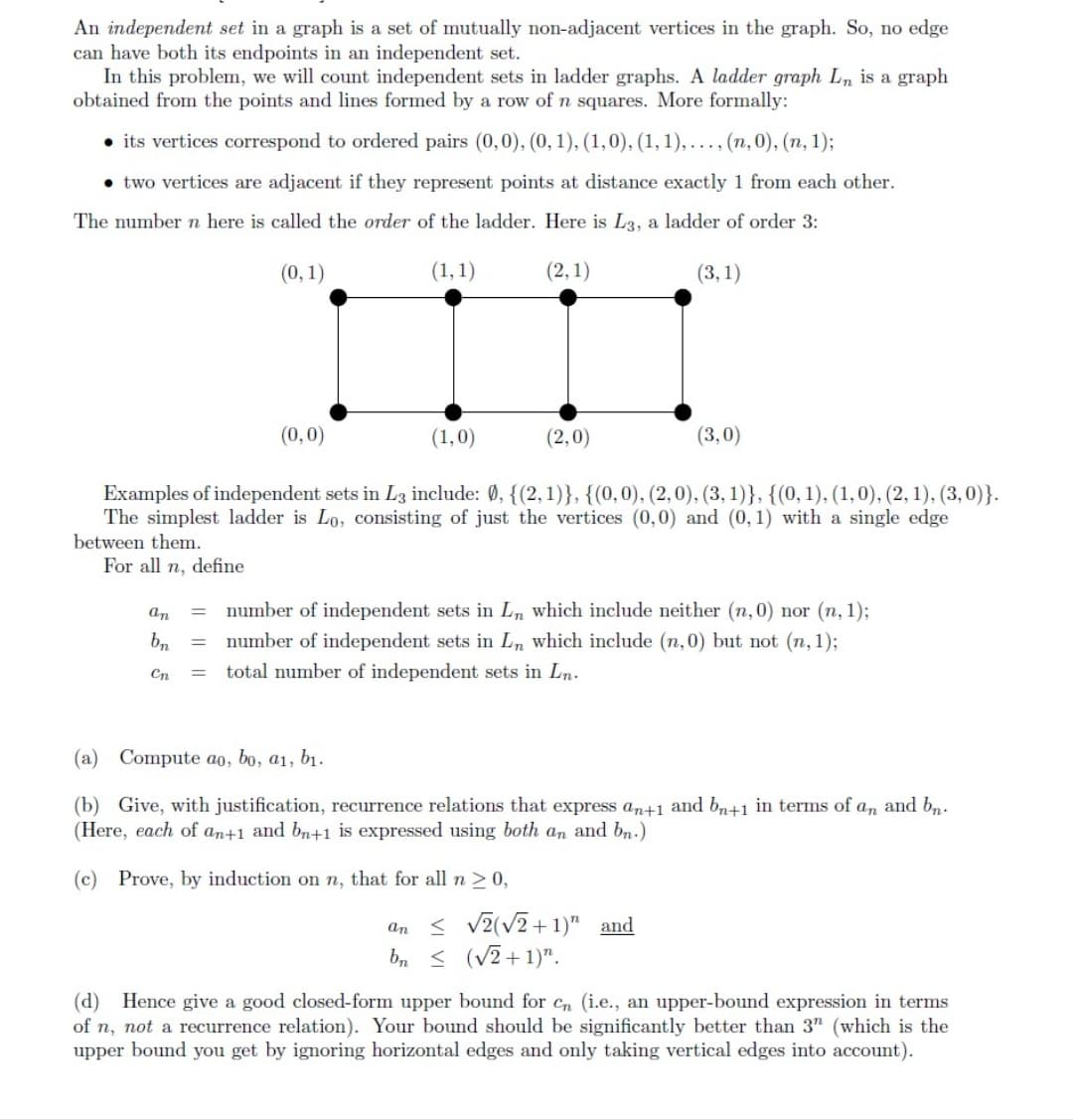An independent set in a graph is a set of mutually non-adjacent vertices in the graph. So, no edge can have both its endpoints in an independent set. In this problem, we will count independent sets in ladder graphs. A ladder graph Ln is a graph obtained from the points and lines formed by a row of n squares. More formally: • its vertices correspond to ordered pairs (0,0), (0, 1), (1,0), (1, 1),..., (n, 0), (n, 1); • two vertices are adjacent if they represent points at distance exactly 1 from each other. The number n here is called the order of the ladder. Here is L3, a ladder of order 3: (0, 1) (1,1) (2,1) (3,1) (0,0) (1,0) Examples of independent sets in L3 include: Ø, {(2,1)}, {(0,0), (2,0), (3, 1)}, {(0, 1), (1,0), (2, 1), (3,0)). The simplest ladder is Lo, consisting of just the vertices (0,0) and (0,1) with a single edge between them. For all n, define (2,0) (3,0) an = number of independent sets in Ln which include neither (n, 0) nor (n,1); bn = number of independent sets in Ln which include (n, 0) but not (n,1); Cn = total number of independent sets in Ln. (c) Prove, by induction on n, that for all n ≥ 0, (a) Compute ao, bo, ai, b₁. (b) Give, with justification, recurrence relations that express an+1 and bn+1 in terms of an and bn. (Here, each of an+1 and bn+1 is expressed using both an and bn.) an < √2(√2+1)" and bn (√2+1)".
An independent set in a graph is a set of mutually non-adjacent vertices in the graph. So, no edge can have both its endpoints in an independent set. In this problem, we will count independent sets in ladder graphs. A ladder graph Ln is a graph obtained from the points and lines formed by a row of n squares. More formally: • its vertices correspond to ordered pairs (0,0), (0, 1), (1,0), (1, 1),..., (n, 0), (n, 1); • two vertices are adjacent if they represent points at distance exactly 1 from each other. The number n here is called the order of the ladder. Here is L3, a ladder of order 3: (0, 1) (1,1) (2,1) (3,1) (0,0) (1,0) Examples of independent sets in L3 include: Ø, {(2,1)}, {(0,0), (2,0), (3, 1)}, {(0, 1), (1,0), (2, 1), (3,0)). The simplest ladder is Lo, consisting of just the vertices (0,0) and (0,1) with a single edge between them. For all n, define (2,0) (3,0) an = number of independent sets in Ln which include neither (n, 0) nor (n,1); bn = number of independent sets in Ln which include (n, 0) but not (n,1); Cn = total number of independent sets in Ln. (c) Prove, by induction on n, that for all n ≥ 0, (a) Compute ao, bo, ai, b₁. (b) Give, with justification, recurrence relations that express an+1 and bn+1 in terms of an and bn. (Here, each of an+1 and bn+1 is expressed using both an and bn.) an < √2(√2+1)" and bn (√2+1)".
Linear Algebra: A Modern Introduction
4th Edition
ISBN:9781285463247
Author:David Poole
Publisher:David Poole
Chapter3: Matrices
Section3.7: Applications
Problem 80EQ
Related questions
Question
Discrete math

Transcribed Image Text:An independent set in a graph is a set of mutually non-adjacent vertices in the graph. So, no edge
can have both its endpoints in an independent set.
In this problem, we will count independent sets in ladder graphs. A ladder graph Ln is a graph
obtained from the points and lines formed by a row of n squares. More formally:
• its vertices correspond to ordered pairs (0,0), (0, 1), (1,0), (1, 1),..., (n, 0), (n, 1);
• two vertices are adjacent if they represent points at distance exactly 1 from each other.
The number n here is called the order of the ladder. Here is L3, a ladder of order 3:
(0,1)
(1,1)
(2,1)
(3,1)
(1,0)
Examples of independent sets in L3 include: Ø, {(2,1)}, {(0,0), (2,0), (3, 1)}, {(0, 1), (1,0), (2, 1), (3,0)}.
The simplest ladder is Lo, consisting of just the vertices (0,0) and (0,1) with a single edge
between them.
For all n, define
(0,0)
(2,0)
an = number of independent sets in Ln which include neither (n, 0) nor (n, 1);
bn = number of independent sets in Ln which include (n, 0) but not (n,1);
Cn = total number of independent sets in Ln.
(c) Prove, by induction on n, that for all n ≥ 0,
(3,0)
(a) Compute ao, bo, a1, b₁.
(b) Give, with justification, recurrence relations that express an+1 and bn+1 in terms of an and bn.
(Here, each of an+1 and bn+1 is expressed using both an and bn.)
an < √2(√2+1)" and
bn ≤ (√2+1)".
(d) Hence give a good closed-form upper bound for en (i.e., an upper-bound expression in terms
of n, not a recurrence relation). Your bound should be significantly better than 3" (which is the
upper bound you get by ignoring horizontal edges and only taking vertical edges into account).
Expert Solution
This question has been solved!
Explore an expertly crafted, step-by-step solution for a thorough understanding of key concepts.
Step by step
Solved in 4 steps with 4 images

Recommended textbooks for you

Linear Algebra: A Modern Introduction
Algebra
ISBN:
9781285463247
Author:
David Poole
Publisher:
Cengage Learning

Linear Algebra: A Modern Introduction
Algebra
ISBN:
9781285463247
Author:
David Poole
Publisher:
Cengage Learning